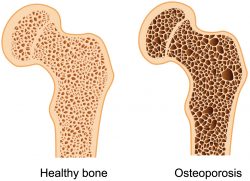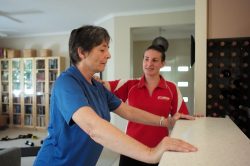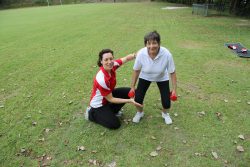 Exercise for bone density
Exercise for bone density
As we age there is a natural decline in our bone density, and if our bones become too weak we may develop osteopenia or osteoporosis, this puts us at higher risk of fractures. Osteoporosis is a common disease in Australia with 1.2 million people estimated to have osteoporosis and further 6.3 million with low bone density. As bones become thinner and less dense, even a minor bump or fall can cause a serious fracture.
We can help slow down the decline in bone density through certain types of exercise – There are two types of exercises that are important for building and maintaining bone density: weight-bearing and muscle-strengthening exercises.
Weight-bearing Exercises
Weight bearing exercises include activities that make you move your own body weight against gravity. Weight-bearing exercises can be high-impact or low-impact.
High-impact weight-bearing exercises help build bones and keep them strong. Certain people who are at high risk of fracture may need to avoid high impact exercise – always check with your doctor.
Examples of high-impact weight-bearing exercises are:
- Dancing
- High-impact aerobics
- Hiking
- Jogging/running
- Jumping Rope
- Stair climbing
- Tennis
Low-impact weight-bearing exercises can also help keep bones strong and are a safe alternative if you cannot do high-impact exercises. Examples of low-impact weight-bearing exercises are:
- Elliptical or cross trainer machines
- Low-impact aerobics
- Stair-step machines
- Fast walking on a treadmill or outside
Muscle-Strengthening Exercises
These exercises include activities where you move your body, a weight or some other resistance against gravity. They are also known as resistance exercises and include:
- Lifting weights
- Using elastic exercise bands
- Using weight machines
- Lifting your own body weight
Get the most out of exercise
The following guidelines come from Osteoporosis Australia
- Exercise must be regular (at least 3 times per week)
- Exercise should progress over time (amount of weight used, degree of exercise difficulty, must increase or vary over time to challenge bones and muscles)
- Exercise routines should be varied (variety in routines is better than repetition)
- Exercise should be performed in short, intensive bursts
Working with guidance
Our Fitness Enhancement Personal Trainers are qualified and experienced to provide guidance to you to help increase bone density through a combination of strength training and weight bearing exercises. We offer one-on-one Personal Training in a variety of settings, as well as small group Personal Training which offers great value for money!
